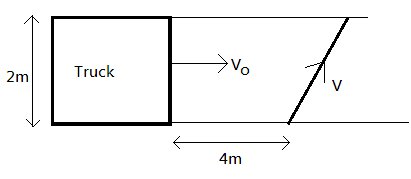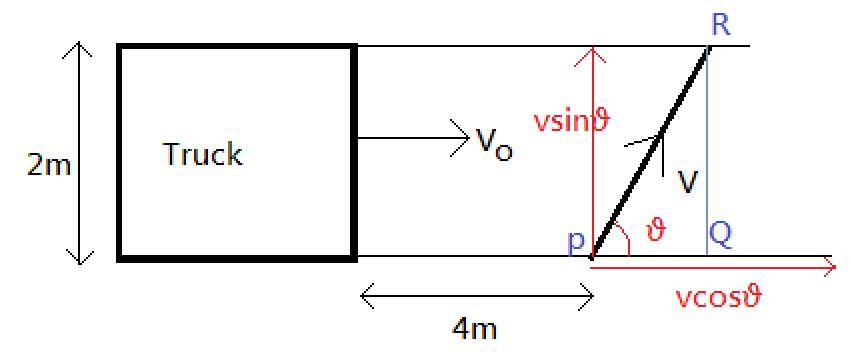
A $2m$ wide truck is moving with a uniform speed ${v_0} = 8m{s^{ - 1}}$ along a straight horizontal road. A pedestrian starts to cross over the road with a uniform speed $v$ when the truck is $4m$ away from him. The minimum value of $v$ so that he can cross the road safely is

A. $2.62m{s^{ - 1}}$
B. $4.6m{s^{ - 1}}$
C. $3.57m{s^{ - 1}}$
D. $1.414m{s^{ - 1}}$

Answer
557.7k+ views
Hint: Split the velocity of the pedestrian in horizontal and vertical components. The distance to be travelled by the pedestrian is $2m$ . The truck is moving horizontally, so for the pedestrian to safely cross the road; the horizontal distance by the pedestrian $(x)\,m$ must at least equal to the distance travelled by the truck $(x + 4)m$ .
Complete step by step answer:
Please note that the pedestrian will take the same time to travel in the vertical direction as much time taken to travel in a horizontal direction. But in the meantime the truck will also move some distance. We know for sure that the pedestrian has to travel a vertical distance of $2m$ .
Consider that the pedestrian travels at an angle $\theta $ with the horizontal as shown below:
And let's split the velocity of the pedestrian.

Note that the distance $PQ = 2\cot \theta $
For vertical direction.
Velocity of the pedestrian $ = v\sin \theta $ and the distance to be travelled $ = 2m$
So, the time taken will be:
${t_p} = \dfrac{2}{{v\sin \theta }}$
Where ${t_p}$ is the time taken by pedestrians.
At the same time the truck will move some horizontal distance. The truck will move a total distance of $4m + PQ = 4 + 2\cot \theta $
The minimum time taken by pedestrians to cross vertical distance will be the same as the time taken by the truck to cover $4 + 2\cot \theta $ distance.
$ \Rightarrow {t_p} = \dfrac{2}{{v\sin \theta }} = \dfrac{{4 + 2\cot \theta }}{8}$
Solving this equation, we will get the minimum velocity for the pedestrian to cross safely.
$$v = \dfrac{8}{{(2\sin \theta + \cos \theta )}}$$ --equation $1$
By properties of differentiation, the minimum velocity is obtained when
$$\dfrac{{dv}}{{d\theta }} = 0$$
$$ \Rightarrow \dfrac{{dv}}{{d\theta }} = \dfrac{{ - 8}}{{(2\sin \theta + \cos \theta )}} \times \left( {2\cos \theta - \sin \theta } \right) = 0$$
$$ \Rightarrow \left( {2\cos \theta - \sin \theta } \right) = 0$$
$$\sin \theta = \dfrac{2}{{\sqrt 5 }}\,;\,\cos \theta = \dfrac{1}{{\sqrt 5 }}$$
Substituting these values in equation $1$ , we get
$v = \dfrac{8}{{2 \times \dfrac{2}{{\sqrt 5 }} + \dfrac{1}{{\sqrt 5 }}}}$
$v = \dfrac{8}{{\sqrt 5 }}$
$v = 3.57m{s^{ - 1}}$
So, the correct answer is “Option C”.
Note:
In such types of questions, remember that the vertical distance is fixed. So, time can be calculated. Now the truck too takes the same time to reach the pedestrian.
Also remember that this is the minimum speed.
The mean time the truck will also move some distance.
Complete step by step answer:
Please note that the pedestrian will take the same time to travel in the vertical direction as much time taken to travel in a horizontal direction. But in the meantime the truck will also move some distance. We know for sure that the pedestrian has to travel a vertical distance of $2m$ .
Consider that the pedestrian travels at an angle $\theta $ with the horizontal as shown below:
And let's split the velocity of the pedestrian.

Note that the distance $PQ = 2\cot \theta $
For vertical direction.
Velocity of the pedestrian $ = v\sin \theta $ and the distance to be travelled $ = 2m$
So, the time taken will be:
${t_p} = \dfrac{2}{{v\sin \theta }}$
Where ${t_p}$ is the time taken by pedestrians.
At the same time the truck will move some horizontal distance. The truck will move a total distance of $4m + PQ = 4 + 2\cot \theta $
The minimum time taken by pedestrians to cross vertical distance will be the same as the time taken by the truck to cover $4 + 2\cot \theta $ distance.
$ \Rightarrow {t_p} = \dfrac{2}{{v\sin \theta }} = \dfrac{{4 + 2\cot \theta }}{8}$
Solving this equation, we will get the minimum velocity for the pedestrian to cross safely.
$$v = \dfrac{8}{{(2\sin \theta + \cos \theta )}}$$ --equation $1$
By properties of differentiation, the minimum velocity is obtained when
$$\dfrac{{dv}}{{d\theta }} = 0$$
$$ \Rightarrow \dfrac{{dv}}{{d\theta }} = \dfrac{{ - 8}}{{(2\sin \theta + \cos \theta )}} \times \left( {2\cos \theta - \sin \theta } \right) = 0$$
$$ \Rightarrow \left( {2\cos \theta - \sin \theta } \right) = 0$$
$$\sin \theta = \dfrac{2}{{\sqrt 5 }}\,;\,\cos \theta = \dfrac{1}{{\sqrt 5 }}$$
Substituting these values in equation $1$ , we get
$v = \dfrac{8}{{2 \times \dfrac{2}{{\sqrt 5 }} + \dfrac{1}{{\sqrt 5 }}}}$
$v = \dfrac{8}{{\sqrt 5 }}$
$v = 3.57m{s^{ - 1}}$
So, the correct answer is “Option C”.
Note:
In such types of questions, remember that the vertical distance is fixed. So, time can be calculated. Now the truck too takes the same time to reach the pedestrian.
Also remember that this is the minimum speed.
The mean time the truck will also move some distance.
Recently Updated Pages
Why are manures considered better than fertilizers class 11 biology CBSE

Find the coordinates of the midpoint of the line segment class 11 maths CBSE

Distinguish between static friction limiting friction class 11 physics CBSE

The Chairman of the constituent Assembly was A Jawaharlal class 11 social science CBSE

The first National Commission on Labour NCL submitted class 11 social science CBSE

Number of all subshell of n + l 7 is A 4 B 5 C 6 D class 11 chemistry CBSE

Trending doubts
What is meant by exothermic and endothermic reactions class 11 chemistry CBSE

10 examples of friction in our daily life

One Metric ton is equal to kg A 10000 B 1000 C 100 class 11 physics CBSE

1 Quintal is equal to a 110 kg b 10 kg c 100kg d 1000 class 11 physics CBSE

Difference Between Prokaryotic Cells and Eukaryotic Cells

What are Quantum numbers Explain the quantum number class 11 chemistry CBSE




